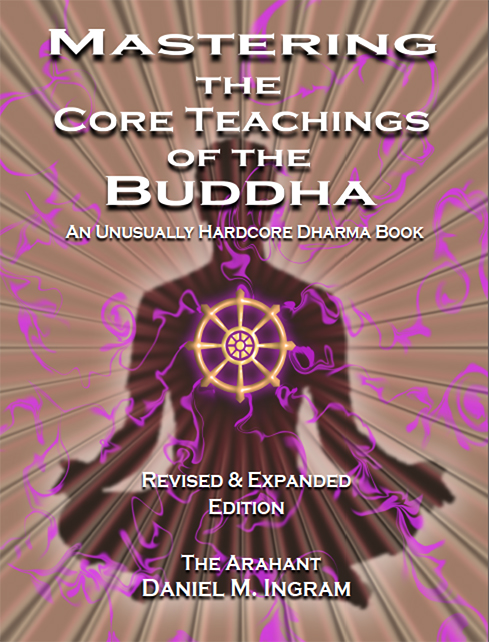Agencylessness
← Untangling | Wobble and Fall →
I thought I would pause here to unpack agencylessness, to explore how the illusory sense of an agent is created in the first place, and how to do something about that. The layers and qualities of mind that create the sense, “I am doing things” are many but not infinite, and so we can debunk them through clear, systematic practice. Focusing directly on these qualities of intentions and actions arising naturally based on causes can be very skillful practice. There are many teachings of the Buddha that address these aspects of practice.
First, we have some perception of intentions as they arise, but it is generally poor perception. That we know what we are going to do before we do it is powerful conditioning for the mind to get a sense that some “I” is performing the actions. However, while intentions arise on their own, naturally, causally, there is insufficient clarity to perceive that, so we get the sense that we are creating the intentions and so controlling actions. In Mind and Body, the earliest insight stage, those who know what to look for and how to leverage this way of perceiving reality will take the opportunity to notice the intention to breathe that precedes the breath, the intention to move the foot that precedes the foot moving, the intention to think a thought that precedes the thinking of the thought, and even the intention to move attention that precedes attention moving. Even before Mind and Body, one of the very first insights that practitioners have is that they can’t control their noisy minds; going deeply into this basic first insight, taken far enough, leads to wisdom.
The relationships between intentions and actions become much more obvious in Cause and Effect, when those who appreciate the remarkable ability to dissect how intentions lead to actions will be rewarded by clear insights into this process. Notice what happens just before you move, speak, or think. Keep attention phase-tuned to that part of the process, that intentionality that knows what is about to occur, that has mapped it out in space, thought, or language before you move, think, or speak. This sort of systematic practice that keeps focused on the sense of the locus of control and planning will set up the foundations of penetrating the illusion of agency.
As the Three Characteristics kicks in, practitioners will notice strange movements and tensions starting to show up in a way that is clearly not entirely in their control. Those who can get past the irritating sensations and hard pains and turn to the no-self aspect of that state will realize that so many sensations arise totally on their own, including the irritating tensions and strange movements. By the time of the A&P, many practitioners will be noticing all sorts of fascinating sensations, vibrations, pleasures, and other rapturous experiences welling up naturally, but many will be too enamored of these experiences to contemplate the remarkable fact of the natural, causal, welling-up itself. Still, if you know what to look for as you cycle through these stages, you can focus on that aspect, the aspect that debunks the agent.
Dissolution tears down so many aspects of the agent. So many aspects of experience are perceived to fall away, dissolve, disappear, and, if we notice that intentions themselves just dissolve even before they lead to actions—that couch-potato effect—then we can gain direct insights into that aspect of the illusion of the agent. The rest of the Dark Night brings up so many experiences naturally, though their unpleasant aspects and the fact that they are hitting so close to home tend to overwhelm many practitioners.
However, those with their eye on the prize of agencylessness will reflect, “Ah, so many experiences arising naturally, totally on their own!” This is gold when it comes to perceiving the naturalness of causality for core aspects of what seems to be the agent. All the protests, frustrations, negotiations, bargaining, strategizing: see all these arise naturally. Tune deeply into the intentions themselves driving those: this can be strangely powerful practice that recovers the clarity at the center that leads to something opening. Keep your morality strong when emphasizing agencylessness, particularly in the Dark Night.
Equanimity is a remarkable stage, in that it begins to encompass the whole layer of mind we are working on as a flowing, integrating, fluxing whole. In that layer are all the core processes, the subtle core intentions, the last holdouts against insight, the core illusions that maintain the sense that there really is some “I” at the core of what is going on. Contemplate those core processes, those last holdouts, those intentions that drive our practice, and perceptually integrate the very center of who you think you are with the rest of the flowing world. Finally, at Conformity, which is really the peak of Equanimity, we break through, even if just for a moment, and Fruition completely takes over after the perfect naturalness of the three doors.
At that point, we have perfectly glimpsed for just a moment not only the illusions that make up the agent, but also perceived that agent to cease, to be absolutely transient. In the restart of reality, we can notice how the illusion is re-established. That careful, meticulous, intentional focus of our investigative mind on the restart can finally convince us, layer by layer, that there truly is no agent and that causality and the lawfulness of reality are real and always have been. As these insights percolate through the layers revealed by each path cycle, we can finally be done forever with the illusion of an agent and never contract into that illusion again.
One thing I should mention about models that involve agencylessness, no-self, equanimity, and the like, as well as sitting through pain, pleasure, boredom, hunger, and all the rest, as is generally required on a serious course of meditation: there is a shadow side that is easily created from passivity, unskillful tolerance for situations that are suboptimal, and a lack of care for yourself and possibly others. With that pain in your chest you might think, it will pass, when perhaps being so cavalier about health is not an adequate plan of care. That need to clean your house, you might say to yourself, just more Mara, more samsara, not really needed. That relationship that you just let crumble—maybe it could have used just a bit more gratitude, attention, and love. You get the picture.
Most insight practices that are very direct, particularly very dry vipassana, as I was doing at that point on that retreat, have not only the potential to create deep wisdom but also have a strong potential to create these sorts of serious shadow problems. Stay on guard against this sort of apathy and self-rationalizing neglect when chasing any ideal such as this one. It is not that agencylessness isn’t a key part of the final prize. It is. But any action, any thought, any intention, any word: all of that was already agencyless and you had yet to realize it. All effort, all drive, happens on its own. Thus, like all the ideals presented in the models of awakening, beware of solidifying it into something unwholesome or detrimental. All right, back to the story …

